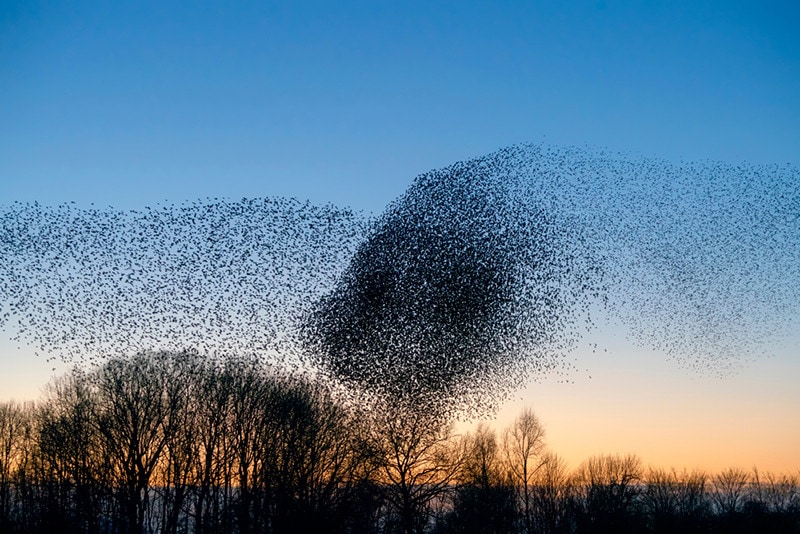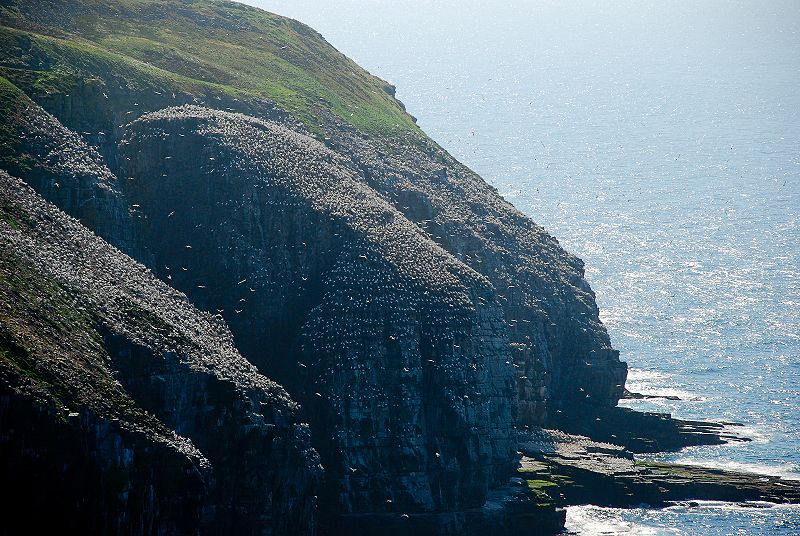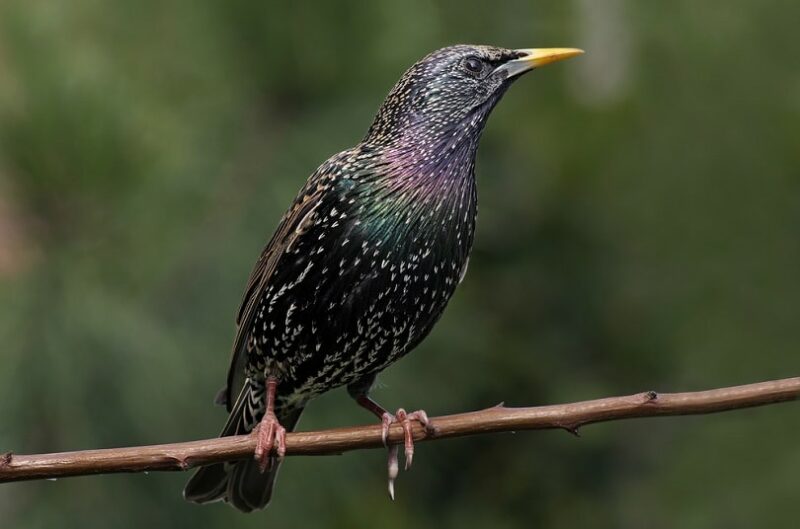Where to See Starling Murmurations in Canada in 2024 (10 Best Places)
Last Updated on

The first time you see a starling murmuration will likely leave a lasting impression on you. It shows nature in all its spectacular glory.
The term “murmuration” is a fancy way of saying flock, but it doesn’t do it justice. It’s an aerial ballet with hundreds and even thousands of European Starlings flying in unison. The great thing for birdwatchers is that they typically return to the same areas every year.1
Canada is an excellent place to see starling murmurations because it marks the transition from year-round populations to the summer breeding range. Let’s check out some of the best places to see them in Canada.

Top 10 Places to See Starling Murmurations in Canada:
1. Baie Verte Peninsula, Newfoundland
https://www.instagram.com/p/Cg6xrXlO2NP/
| Type of spot | Park |
| Difficulty Level | Easy to moderate |
| Common birds seen | European Starling, waterfowl, thrushes, warblers |
| Fee | None |
| Website | https://www.newfoundlandlabrador.com/ |
Baie Verte Peninsula has so much to explore. Birdwatching is only the tip of the iceberg, but those are in abundance, too. The boreal forest provides excellent habitat for the 401 avian species found in Newfoundland. The European Starling is a common visitor that breeds in this area. You can catch them as they migrate south for the winter.
- Wide variety of other bird species found in boreal forests
- Plenty of nearby trails and parks
- Suitable for beginner or experienced hikers
- Off the beaten path
2. Cape St. Mary’s Ecological Reserve, Newfoundland and Labrador

| Type of spot | Natural area |
| Difficulty Level | Easy to Challenging |
| Common birds seen | European Starling, waterfowl including the Northern Gannet |
| Fee | Contact the park directly |
| Website | https://www.newfoundlandlabrador.com/plan-and-book/attractions/10525819 |
Cape St. Mary’s Ecological Reserve is a must-see when it comes to birdwatching, especially if you’re trying to cross some life listers among the seabirds. The area is protected and offers a lot to do.
Hiking can be challenging at times, particularly on the cliffs. It can also get downright chilly in the fall. Only service animals are permitted. The park closes for the season in mid-October.
- Wide variety of other bird species
- Plenty of recreational opportunities
- Suitable for beginning to advanced hikers
- Seasonal access
- Service dogs only
3. Burns Lake, British Columbia (BC)

| Type of spot | Town with nearby lake |
| Difficulty Level | Easy to moderate |
| Common birds seen | European Starling, waterfowl, songbirds |
| Fee | None |
| Website | https://visitburnslake.ca |
Burns Lake is worth a visit if just for the scenery. It’s a pretty area within the area’s Lakes District. The town has many parks and trails for more birdwatching opportunities.
Researchers have documented sightings of many starlings since 1949. It’s also well-known as a fishing hotspot as Canada’s second largest natural lake. It’s best visited by car so that you can hit the other bird watching areas as well.
- Wide variety of other bird species
- Plenty of recreational opportunities
- Suitable for beginning hikers
- Off the beaten path
4. Charlottetown, Prince Edward Island (PEI)

| Type of spot | City |
| Difficulty Level | Easy |
| Common birds seen | European Starlings |
| Fee | None |
| Website | https://www.discovercharlottetown.com/ |
Charlottetown is the largest city and capital of PEI. You’ll need a car even if you fly into the town’s commercial airport. Your destination is the Hillsborough Bridge, the gathering spot for the starlings.
The birds fly in from all around the area to this place, with daily flights starting in the fall. It isn’t your typical birding hotspot since you’re right in town, but it doesn’t take away from the show.
- Suitable for beginners
- Plenty of other local attractions
- Regular murmurations until winter
- Not surrounded by nature
5. Truro, Nova Scotia (NS)
https://www.instagram.com/p/CrGRFAUodIU/
| Type of spot | Town |
| Difficulty Level | Easy |
| Common birds seen | European Starlings |
| Fee | None |
| Website | https://www.truro.ca |
Truro, NS is another town hotspot for starlings. These birds are so used to people that it doesn’t matter where they go. The thing that gets them riled up is the sight of a predator, like a hawk.
This setting provides plenty of spots to roost. Again, fall is prime time for the avian show when birds from the surrounding areas come to partake. Truro is accessible by train or car from the mainland.
- Beautiful scenery
- Fun downtown with local shops and restaurants
- Lots of recreational opportunities
- Short history of regular murmurations
6. Williams Lake, British Columbia
https://www.instagram.com/p/BToHD9EAo6p/
| Type of spot | Town |
| Difficulty Level | Easy |
| Common birds seen | European Starling |
| Fee | None |
| Website | https://www.williamslake.ca |
Williams Lake might be more well-known for its rodeo than birdwatching, but it has a long history of starling activity. Researchers documented breeding site fidelity and, thus, the regularity of the murmurations going back to the late 1940s.
Nearby, Onward Ranch is another place where you may see these avian performances. It can be hit or miss, but you’ll have lots to do in the meantime.
- Long history of activity
- Nearby places to dine and stay
- Suitable for beginning birdwatchers
- No reliable spots for murmurations
7. Lesser Slave Lake Provincial Park, Alberta
https://www.instagram.com/p/CED1y1bHiI1/
| Type of spot | Park |
| Difficulty Level | Easy to moderate |
| Common birds seen | European Starling, waterfowl, warblers, finches, raptors |
| Fee | None |
| Website | https://www.albertaparks.ca/parks/north/lesser-slave-lake-pp/ |
Lesser Slave Lake Provincial Park in Alberta should be on any birdwatchers’ list since it is part of the breeding range of roughly 300 species, including European Starlings. You can take your birdwatching to the trails, which are of varying lengths.
The park has a bird banding program. It’s one of only a few located in boreal forests. We suggest contacting the park for closures before visiting.
- Wide variety of other bird species
- Plenty of recreational opportunities
- Camping available
- Off the beaten path
https://www.instagram.com/p/B1bdF4SFVko/
| Type of spot | Park with coastline |
| Difficulty Level | Easy to Challenging |
| Common birds seen | European Starling, waterfowl, warblers, finches, sparrows |
| Fee | $9.25 per adult |
| Website | https://www.sepaq.com/pq/bon/index.dot?language_id=1 |
Bonaventure Island and Percé Rock in Québec is the largest migratory bird sanctuary on the continent, making it a no-brainer to add to our list. It is a national park with a daily visitor limit.
You should book your access online to make sure you can get into the site. It has several hotspots you can visit. We suggest checking with the office to get up-to-date information about where to go.
- Wide variety of other bird species, especially seabirds
- Plenty of hiking trails
- Largest migratory bird sanctuary
- Daily visitor limit
9. Long Point Provincial Park, Ontario
https://www.instagram.com/p/CgQG5zSpGrn/
| Type of spot | Park with coastline |
| Difficulty Level | Easy to Challenging |
| Common birds seen | European Starling, waterfowl, warblers, finches, sparrows |
| Fee | Day-use permit required |
| Website | https://www.facebook.com/LPBObs/ |
The appropriately named Long Point Provincial Park in southwestern Ontario is a bird watching paradise with nearly 400 species observed here. The site has three research stations located on a peninsula, the world’s longest sandspit. The park conducts daily bird banding demos so that you can chat with the staff about good locations and current sightings. Unfortunately, it’s only open until 4:00 p.m. daily.
- Daily bird banding demos
- Diverse collection of birds
- Beautiful scenery
- UNESCO World Biosphere Site
- Open only to 4:00 p.m.
10. Point Pelee National Park, Ontario
https://www.instagram.com/p/ChuWSZRuJ_a/
| Type of spot | Park with coastline |
| Difficulty Level | Easy to Challenging |
| Common birds seen | European Starling, waterfowl, warblers, finches, sparrows |
| Fee | $9.25 per adult |
| Website | https://parks.canada.ca/pn-np/on/pelee |
Point Pelee National Park is a national treasure as the country’s most ecologically diverse. You’ll see a lot more birds than only starlings. You may get a chance to see migrating Monarchs if you time your visit right.
The site has reservable oTENTik A-frame cabins so that you can get an early start on birding. The park also hosts its annual Festival of Birds in May to meet fellow enthusiasts.
- Festival of Birds in May
- Rare opportunity to see migrating Monarch Butterflies
- Ecologically diverse
- oTENTik A-frame cabins for camping
- 43 out of 52 warbler species
- Daily visitor limit

How European Starlings Form Murmurations
This question has puzzled scientists for decades. Researchers concluded that the birds aren’t moving in sync with the entire flock or constellation of starlings. Instead, they rely on the movements of the seven or so birds flying around them. When you see a murmuration, it looks like they’re standing on top of one another.
They do it for warmth and also survival. The birds feel safe if in the middle of that flock of 1 million birds. It also confuses would-be predators, not unlike a school of fish. It’s the same with starlings. It’s worth noting that technicians modeling these movements have used them to create video games and movie special effects.

Migratory Behaviour in Starlings
Starlings migrate during the day at about 1,000 meters, depending on the weather. Interestingly, scientists theorize that the birds use familiarity with the topography and the sun’s position to navigate. Researchers have observed that starlings are more likely to deviate from their route if they fly over water. These findings support land features like this are vital to staying the course.
Starlings are intelligent birds and can learn patterns readily, such as the sun’s angle and its relationship to time. We’ve discussed how they return to the same breeding areas, making it possible to go to places where murmurations regularly occur. Juvenile birds learn these locations after migrating with the adults leading the way. These behaviors continue with each generation because birds are social creatures.
Starlings start gathering in late summer. Fall marks the beginning of the large murmurations as the birds take off on the main push to their wintering grounds.
FAQs
When is the best time to see the starling murmurations?
Dusk is ideal when the birds are coming back to roost for the night. The annual migration starts in the fall and continues until close to the beginning of winter.

When and how did European Starlings get to North America?
The story is something out of a book—literally! The birds were intentionally released in New York City’s Central Park in 1890. Enthusiasts of the works of William Shakespeare wanted all the animals referenced in his books to live there. The initial 60 European Starlings turned into the 150 million birds that exist worldwide today. They live throughout southern Canada with breeding ranges up north.

Conclusion
The European Starling may not be everyone’s favorite bird, but its dazzling murmurations have made an impact. How they can fly without bumping into each other is a mystery. It’s another of the many things that scientists have yet to learn about our feathered friends. These spectacles remind us of the beauty and secrets that Mother Nature has yet to reveal to us mere humans.
See also:
Featured Image Credit: Albert Beukhof, Shutterstock
Table of Contents
- Top 10 Places to See Starling Murmurations in Canada:
- 1. Baie Verte Peninsula, Newfoundland
- 2. Cape St. Mary’s Ecological Reserve, Newfoundland and Labrador
- 3. Burns Lake, British Columbia (BC)
- 4. Charlottetown, Prince Edward Island (PEI)
- 5. Truro, Nova Scotia (NS)
- 6. Williams Lake, British Columbia
- 7. Lesser Slave Lake Provincial Park, Alberta
- 8. Bonaventure Island and Percé Rock, Québec
- 9. Long Point Provincial Park, Ontario
- 10. Point Pelee National Park, Ontario
- How European Starlings Form Murmurations
- Migratory Behaviour in Starlings
- FAQs
- Conclusion
About the Author Chris Dinesen Rogers
Chris has been writing since 2009 on a variety of topics. Her motto with all of her writing is “science-based writing nurtured by education and critical thinking.” Chris specializes in science topics and has a special love for health and environmental topics, and animals of all shapes and sizes.
Related Articles:
10 Types of Hummingbirds in Arkansas (With Pictures)
8 Types of Hummingbirds in Nebraska (With Pictures)
5 Types of Hummingbirds in Idaho (With Pictures)
3 Types of Hummingbirds in Mississippi (With Pictures)
8 Types of Hummingbirds in Kansas (With Pictures)
5 Types of Hummingbirds in West Virginia (With Pictures)
5 Types of Hummingbirds in Ohio (With Pictures)
Where Do Nuthatches Nest? Nuthatch Nesting Habits Explained
